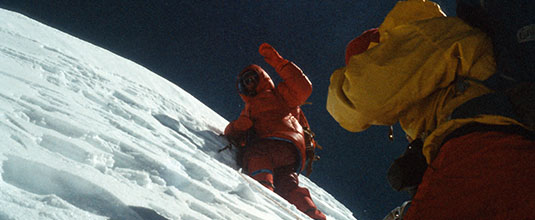I tak się to zaczęło. Łaziliśmy po kominach, a myśleliśmy o Lhotse. (...) Jedni na tych kominach wisieli dłużej, inni krócej. Ci drudzy odpracowywali swój udział w czynnościach ściśle organizacyjnych. Jeździli na przykład daleko w Polskę po odpowiedni na śpiwory i kurtki puch, gonili za wszystkim, bez czego nie może obejść się himalajska wyprawa.
Jest rok 1978. W gabinecie wisi na ścianie godło państwowe, obok biurka stoi rachityczna paprotka, w oszklonej szafce na półce kilka tomów dzieł Lenina. A przez okno widać wielki, stary komin. Chodzi właśnie o ten komin, jednak wszystko jest tutaj starannie przemyślaną grą, w której nie można popełnić błędu. Więc unosimy się z krzeseł, na których ledwo zdążyliśmy usiąść.
- Rozumiemy. To my w takim razie... Może innym razem. Wyraźnie robimy ruch w kierunku drzwi. Ale gra trwa, jeszcze nic nie wiadomo.
- Zaraz, zaraz, chwileczkę. Porozmawiajmy trochę...
Bo dyrektor wie, że my wiemy, że kolos, jakim jest Hutnicze Przedsiębiorstwo Remontowe potrafi zrobić wszystko, nawet postawić od nowa wielki piec. Na wszystko ma plany, horrendalne kosztorysy, narzuty. Tylko na malowanie kominów akurat nie ma z reguły czasu. Dlatego dyrektor świadom, że może coś jego majestat na tym nawet ucierpi, nie pozwala nam jednak wyjść z gabinetu.
- Ciekaw jestem, ile też czasu panowie na to potrzebują?
Za oknem widać ten potężny, chociaż już mocno odrapany komin, patrzymy w jego kierunku i kręcąc głowami, wykrzywiając przy tym usta w podkowę, mówimy:
- Ze dwa tygodnie. Może dalibyśmy radę i w tydzień.
- Tydzień? - Dyrektor poprawia się w fotelu, jest wyraźnie rozbawiony. Punkt dla niego. - Tydzień, wiecie, nie wystarcza, żeby postawić samo rusztowanie...
- Bo my malujemy bez rusztowań.
- To jak?
- Na linach.
Z początkiem września docieramy wreszcie do bazy pod Everestem i Lhotse. Po trudach podróży przez niziny, puszcze, zmaltretowani przez pijawki, które o tej porze roku są zmorą wszelkich zarośli Nepalu, jesteśmy w miejscu, o którym tak dużo słyszałem i czytałem. W miejscu, o którym tak często od dawna marzyłem. Wynajdujemy miejsce pod namioty i stawiamy je, wygrzebujemy z bębnów wszystko co potrzebne, na każdym kroku czeka masa robót czysto gospodarczych. Trwa to trzy dni i dzieje się na wysokości 5400 metrów. Nastąpiło więc pierwsze zetknięcie się z wysokością, która nawet najprostsze czynności zamienia w męczarnie.
Teraz psuje mi humor tylko jedna rzecz: że pójdziemy na Lhotse drogą klasyczną i tym samym niczego nowego nie wniesiemy. Zastanawiamy się z Januszem Skorkiem i Andrzejem Czokiem, czyby jednak nie pójść nieco bardziej w prawo i zrobić direttissimę zachodniej ściany. Wszystko to jest wynikiem myślenia kategoriami tatrzańskimi, i nie warto ryzykować. W czasie tych rozważań u podnóży najwyższych gór świata zrodził się inny pomysł. Spróbujemy zrobić Lhotse bez tlenu. Początkowo postanowiło podjąć tę próbę czterech z nas. Oprócz Andrzeja Czoka i mnie, Janusz Skorek i Zyga Heinrich. Zyga jednak bardzo szybko "odpuścił". Pewnego dnia zakomunikował: - Iść tam bez tlenu, to za duże ryzyko. I nikt z nas się temu nie dziwił. Pamiętajmy, że podejmowaliśmy tę decyzję jeszcze w latach, w których pokutowała teoria o złych następstwach niedotlenienia mózgu na dużych wysokościach. Miało to prowadzić do trwałych zmian w mózgu. U nas, w bazie, mówiło się o tym żartem, w rodzaju: Zobaczysz, jak ubędzie ci połowa szarych komórek... będziesz przygłupem..
Powolutku, powolutku... Dziesięć kroków, odpoczynek, w czasie którego zwisam całym ciężarem na wbitym w śnieg czekanie tak długo, aż się uspokoją płuca. Znowu dziesięć kroków. Zaczyna się ten rytm walki na wysokości. Liczę dziesięć kroków, na które nastawiłem "zegarek" własnego organizmu, po chwili zmuszam się do następnych dziesięciu. Najgorzej jest poddać się i usiąść, bo "zegarek" przestaje działać. Wtedy gubi się ten zbawczy rytm bezpowrotnie, a kolejne "nakręcenie" trwa bardzo długo. I dalej, już tylko te ostatnie z najcięższych kroków. Wchodzimy na szczyt.
























